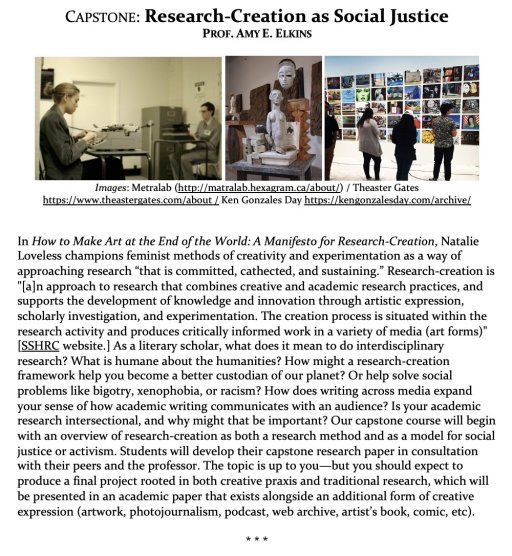
My classroom is a space of radical joy and intentional learning aimed at guiding students to connect in new and powerful ways with literary texts, with each other, and with their larger social worlds. My teaching centers on various modes of student-driven inquiry, experiential learning, and engagement with a generous, global community of scholars who are both critical and creative thinkers. As a graduate student, my teaching was recognized by a university-wide teaching award, and I was voted 2020 Educator of the Year at Macalester College. I speak internationally about practice-based approaches to humanities pedagogy and currently cross-list courses with Environmental Studies and Women’s, Gender, and Sexuality Studies.
I teach courses primarily on British, Irish, and diasporic literature from the early-20th century to the present (the full list can be found on my CV). My teaching emphasizes cultural diversity in literature and media, in addition to close reading, critical thinking, and the cultivation of “stylish” academic writing. My classes cover topics such as modernism and its afterlives, visual and material culture, the politics of aesthetics, diasporic and global literature, sexuality and queer theory, and studies of the natural world. I teach using artists’ books, archives, and rare books, and I co-authored a peer-reviewed article on Seamus Heaney’s poetic cartographies with an undergraduate advisee. As part of my courses, I have hosted visiting writers such Aminatta Forna and Karen Tei Yamashita, as well as a book cover designer, an Irish ceili dance instructor, and traditional Irish musicians. In conjunction with traditional course discussion, students in my classes often learn-through-doing via service learning, community-engaged projects, group tours of writer’s homes, visiting museum exhibits, and hiking assignments. Extending my pedagogy of praxis, I integrate makerspaces, handmaking, and art-making into my classes. One such assignment asks students to paint alongside the artist, Lily Briscoe, in Virginia Woolf’s To the Lighthouse. Other assignments ask students, for example, to work with collage as a way to theorize rupture and repair in fiction and theory, or to create visual manifestos as a response to feminist modernisms. I also teach research in the library stacks by guiding students to craft “book spine poems,” illuminating narrative form with object studies, and by incorporating art-making as part of literary inquiry through erasure poetry, found object sculpture, lumen print photography, and handicraft.
Reading and discussion take multimedia forms in my classes, and I enjoy working across “texts” in an expanded sense. My students have created video essays, designed movie posters and book covers, and I sometimes pair podcasts and poems to promote cross-media discussion. I have also used Instagram in place of the traditional response paper—a platform that changes the audience for student writing in productive ways, and I’m interested in the use of discussion platforms (such as Slack) for building archives of collective knowledge-building. Taking an experiential, multimedia approach to literary study and intellectual praxis fosters a learning environment that decenters traditionally exclusionary hierarchies and enriches students’ experiences of learning. This approach grows out of my reading of Black and intersectional feminism, my curiosity about the neuroscience of creativity, and my research in art theory and craft studies.








You must be logged in to post a comment.